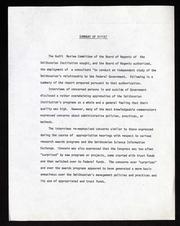The Smithsonian Institution is a “trust instrumentality” of the United States—an organization established by the U.S. government as a public trust. Created by the US Congress on August 10, 1846, through 9 Stat. 102, the Institution carries out the bequest of James Smithson (1765-1829) to create an establishment “for the increase and diffusion of knowledge among men.” Since 1846, public laws, judicial decisions, court cases, procedures of the Board of Regents, executive orders, and government reports have shaped the Institution’s legal structure. The resources on this site will allow you to explore the legal documents that have shaped the Institution since its founding in 1846.
The Bequest

Act of Establishment
Public Laws

Congressional Resolutions

Judicial Opinions

Court Cases

Executive Orders

Special Reports
 A variety of special reports on the legal history of the Smithsonian, such as the Hughes Report of 1977, provide a window onto the complex legal issues the Institution faces.
A variety of special reports on the legal history of the Smithsonian, such as the Hughes Report of 1977, provide a window onto the complex legal issues the Institution faces.
Smithsonian Legal Documents Database
The Smithsonian Legal Documents database is a source of citations to legal documents related to the history of the Smithsonian. It contains all Smithsonian-related US Statutes at Large, selected wills, reports, decisions of attorneys general, executive orders, memoranda of understanding, court cases, minutes of the Board of Regents, and other materials.
The database can be searched through the History of the Smithsonian catalog in the Smithsonian Institution Research Information Center. Enter your search terms and limit your search to the Smithsonian Legal Documents database.
